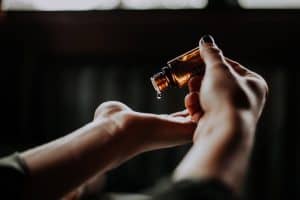Peppermint Essential Oil Benefits And Uses Explained

- What Is Peppermint Essential Oil?
- What Is Peppermint Oil Good For?
- Peppermint Oil Benefits For Skin
- Peppermint Essential Oil For Hair And Hair Loss
- Peppermint Oil For Headaches
- Peppermint Essential Oil For Toothaches
- Peppermint Essential Oil For Stomach Issues
- Peppermint Essential Oil For Sore Throats
- Is Peppermint Oil Safe For Dogs?
- Conclusion
I’m quite sure that we should all recognize the smell, taste, and texture of peppermint. It’s quite common, and it’s very nostalgic for some. Perhaps you’ve had it in a tea or smelled it growing in a garden at some point? Maybe as young children, you and your siblings enjoyed eating peppermint candies? It’s even a common ingredient in many cosmetics and soaps. In fact, it’s highly unlikely that you’ve never encountered peppermint before, as the essential oil of the peppermint plant is found in a lot of everyday products like shampoos, chewing gum, teas, air fresheners, and a lot more.
Peppermint is really easy to grow, and it is very cheap to cultivate. It has been a part of human history for thousands of years. It was referenced during the Greek, Roman and Egyptian empires as a flavoring and antiseptic. They also used it for pain relief.
Peppermint, in its natural form, has such a wide variety of benefits and uses that it’s well worth growing in your garden. Theessential oil in the peppermint bush is even more effective. And it can also be used for a wide variety of purposes. In fact, I personally think there should be a bottle of this stuff in every home! Keep on reading to find out why you should add this to your wellness kit.
What Is Peppermint Essential Oil? Where Does It Come From?

Peppermint oil in use.
Peppermint is a hybrid mint, meaning that it is a mix of watermint and spearmint. Western peppermint comes from Mentha piperita, while Chinese peppermint comes from Mentha haplocalyx.
Peppermint is native to Europe, certain parts of the Middle East, and North America. It generally grows in cooler climates, in areas that are well-shaded and have a lot of moisture. Peppermint essential oil is extracted from the leaves of the peppermint bush, generally through a process of steam distillation. The leaves are then crushed and placed inside a container. Steam enters the container and extracts the nutrients from the organic matter through an evaporation process. The steam then passes through another glass tube and gathers in a condensation chamber. This then forms droplets and eventually the finished product.
Peppermint essential oil has a very distinctive scent. It naturally contains menthone, among other ingredients. This helps give it its minty smell and invigorating quality. Peppermint essential oil is safe for consumption and topical application. However, it is more concentrated than other essential oils. Consequently, you should dilute it with a carrier oil before applying topically.
Peppermint has strong antiseptic, antibacterial, and antimicrobial properties. It can be used to treat wounds, sores, and boils, among other skin irritations. It absorbs easily into your skin and does not leave any greasy layers that can clog up your pores and lead to blockages or blemishes. Peppermint is also a potent natural analgesic which means that it treats pain (superficially or internally).
What Is Peppermint Oil Good For? Peppermint Oil Uses Explained

Tea being poured.
Whenever I have a headache, I generally make a cup of strong rooibos or yellow label tea and add a good branch of crushed peppermint. It’s best to let it sit for a short while and inhale as much of the steam as you can through your nose. I always keep a small supply of peppermint in a reusable plastic container at the office for exactly this reason.
Another one of the health benefits of peppermint essential oil is that it works well as a joint and muscle relaxer. It can relieve joint and muscle pain when it is massaged into your skin around the affected area. It also has a cooling effect, which many people enjoy. However, I generally recommend that you blend this oil with eucalyptus oil or tea tree essential oils for faster effects.
Peppermint essential oil is also commonly used in treating sunburns. Due to the fact that it acts as a natural cooling agent, it helps to function as a pain killer and also helps to ease the discomfort of sensitive sunburns.
Peppermint is just such an amazing plant, honestly. For instance, it generally grows best just before or during the wintertime – the height of flu and cold season. The plant and the oil both work well in treating a fever. Both will reinvigorate your senses and leave you feeling energized. This can help you combat the effects of the flu. The strong odor will also help to relieve you of rhinitis (blocked nose and post-nasal drip).
You can consume the plant and the oil raw. Alternatively, you can add it to tea to help heal a sore throat by loosening mucus and easing pain. It will also kill off any germs that lead to or worsen your infection, thus speeding up the healing process. Peppermint is like a gift from nature for the flu season!
You can check with your health care professional to see if peppermint essential oil can help with some of your ailments. But we’ve gathered a rundown of some of its benefits.
Peppermint Oil Benefits For Skin And Acne
Due to peppermint’s strong natural antiseptic and antimicrobial qualities, it’s incredibly effective for treating surface-level skin issues such as acne, wounds, rashes, burns, and boils. It can also help with conditions like eczema and psoriasis. The cleansing properties of peppermint essential oil mean that not only does it work to kill off any germs that generally linger on the surface of your skin (and can lead to irritation or infection), but it also nourishes and rejuvenates the skin cells. This allows for long-term protection for skin that looks both brighter and healthier.
What makes peppermint oil good for treating the symptoms of eczema? It soothes the irritated area, and the antiseptic qualities help to fight infections that may be caused by openings on the skin. The moisturizing properties of the oil will also nourish your skin and lessen the effects of dryness. This is one of the main symptoms of dermatitis. This will help to slow the spreading of the rash and to ease itchiness.
Unique Compounds In Peppermint Essential Oil
Some very important compounds in peppermint essential oil are menthol, (1,8) cineole oil and limonene. These are the primary agents in treating acne sores and helping the skin heal. Menthol acts as a light, local anesthetic and will help to make treating the sores less painful. Cineole oil and limonene are more directly useful when treating acne, as they contain large amounts of vitamin E and act as strong, natural antiseptics.
This means that the compounds clear out your pores and remove excess sebum oil and dead skin cells. The essential oil of the peppermint bush works really well as a natural toner. This is particularly effective when combined with orange and tea tree oil.
Eczema (or dermatitis) is generally caused by an allergic reaction, chemical irritation or a slowing/clotting of the blood cells in your veins. This may occur for a number of reasons, such as long periods of immobility. Eczema affects over 300 million people around the world. It is characterized by a painful (and often itchy) rash or redness of the skin and sometimes even blisters. Treating this disorder generally involves applying harmful chemical steroid creams that could even worsen the condition in some skin types.
Peppermint Oil For Hair And Hair Loss

Peppermint oil helps hair growth.
Hair loss is common with aging in men – especially those who have a genetic tendency for pattern baldness. It generally relates to a buildup of a chemical compound known as alpha 5 -reductase. This occurs when testosterone builds up in the skin layer just under the hair follicles and then converts to the alpha 5 -reductase.
This compound then blocks the pores and can slow hair growth by starving the hair of essential nutrients as well as causing hair to fall out if it’s not treated soon enough. Unfortunately, it’s generally only noticeable when it’s too late.
Because your scalp is so similar to other parts of your skin, it will heal in the same way. As (1,8) cineole oil and limonene work on clearing your skin, the combination of these two compounds also works to keep your scalp clear and getting rid of excess skin cells and sebum oil that can also block your pores and slow hair growth.
When combined with orange or lemongrass oil (which contains high amounts of linalool – a chemical that actively inhibits the production of the alpha 5 -reductase), the mixture can help to slow hair loss and even promote hair growth by thinning out the blood cells under your scalp to allow for better circulation and more nutrients to your hair follicles.
The strong antiseptic and antimicrobial qualities of peppermint oil also help give it its anti-inflammatory properties. They also help to ease irritation on the scalp which often leads to dryness and the symptoms of dandruff. By massaging the oil into your scalp after showering and combing your hair, the acetate in peppermint oil helps to balance the oil in your hair and clings to the dead skin cells – making them easier to comb out.
As mentioned earlier, peppermint oil is a natural analgesic. This means that it helps to relieve pain. It works in a number of ways to treat the affected area and has little to no additional side effects (unlike most chemical painkillers), so long as it’s taken in a reasonable dosage.
Peppermint Oil For Headaches

Woman with headache.
Tension headaches are a common result of stress, or as the name describes, tension. They’re common if you have a genetic disposition for them or if you have a high-stress lifestyle. And let me tell you, they are not fun. Luckily, one of the benefits of peppermint oil is that it treats headaches. Just apply the oil (undiluted) directly to your temples and massage slowly, in circular motions.
You can also apply a few drops of peppermint oil behind your jawbone and across your forehead for faster relief. I would also recommend a steam treatment with 6 to 8 drops of the oil if you can. Simply add the drops to a pot of boiled water (steam is essential), cover your head with a towel to create a tent, close your eyes, and breathe the moisture in for roughly 3 to 5 minutes at a time. This should help to relieve any general head pain.
Peppermint Essential Oil For Toothaches
Peppermint oil is a common ingredient in many toothpastes and dental products. This is because it’s a natural anti-fungal agent, has analgesic qualities, and is a strong antiseptic. To treat a toothache, simply dab some pure peppermint oil onto the affected tooth with a cotton swab or clean cloth and allow it to rest. It’s important not to consume any hot or cold drinks while the oil gets to work. Otherwise, you will wash it away (I suggest tap water at room temperature through a straw). The oil will also freshen your breath and kill any germs in your mouth that may lead to a fungal infection.
Peppermint Essential Oil For Stomach Issues
Peppermint oil works well to ease nausea and relax irritable bowel syndrome (IBS) due to its antispasmodic properties. You can ingest it orally or inhale the scent nasally for the oil to take effect in treating your nausea. It works to ease the smooth muscle in your stomach, allowing it to break down bile. This lets food pass through your stomach quickly, minimizing abdominal pain. Peppermint oil capsules particularly have been shown to relieve IBS symptoms. Use enteric-coated ones, which will ensure that the capsule won’t dissolve until it reaches your intestines.
Peppermint oil might also help to ease indigestion and prevent spasms in the GI tract. And it’s also a useful oil to prevent bloating. Plus, it is a good way to tame flatulence.
Yet be careful. One of the effects of peppermint oil is that the menthol in it can provide a numbing and soothing effect. This can relax the valve which separates the stomach from the esophagus. Consequently, stomach acids can move upwards in the esophagus more easily, irritating heartburn.
There are even those who say that peppermint oil can help treat colic, but you should definitely check with your doctor before using it for your baby.
Peppermint Essential Oil For Sore Throats
You’ve probably tried many of the classic remedies for a sore throat, but it’s time to add peppermint oil to the mix. If you are suffering from a cold or a scratchy throat, mix together a few drops of peppermint essential oil with warm water and half a teaspoon of rock salt. By gargling with this mixture once or twice a day, you’ll help reduce inflammation and kill bacteria.
Peppermint essential oil’s antimicrobial properties can help defend your body against pathogens.
Additionally, peppermint contains menthol, which is used in many medicines for sore throats.
Is Peppermint Oil Safe For Dogs?

Peppermint Oil is safe for dogs.
When it comes to essential oils, most pet owners know they should be treading carefully. What works for humans, doesn’t necessarily work for animals. If you thought that went without saying, you would be surprised! In an attempt to properly care for your pet, let’s take a closer look at the crucial question: is peppermint oil safe for dogs? And while we’re at it, is peppermint oil safe for cats?
Research shows that peppermint oil may be potentially toxic to your furry friend. Although it’s touted as a remarkably effective flea treatment, thanks to its insect repelling properties, there is little regulation for these sorts of home remedies which means that you might be exposing your pet to more than they bargained for. The bottom line is that you don’t want to risk potential toxicity on your beloved pet. Although it’s valid you want to use more natural alternatives, it’s always important to proceed with caution when it comes to essential oils for your pets.
Conclusion
I always have peppermint growing in my garden, as well as on my kitchen windowsill. It brings a lovely odor to my home and grows very quickly. In fact, I need to trim the bush in my garden regularly in the winter because the root system grows very quickly.
You’ll find that buying even one plant can provide you with enough peppermint forever if you treat it well. It’s really great to have during the wintertime for teas and other dishes. (In fact, peppermint jelly goes as a great relish with lamb and even poultry dishes in the right amount.) And it will do wonders for your immune system and general health.
Putting some peppermint essential oil in your diffuser or oil burner as part of aromatherapy will definitely liven up your home and help you feel relaxed. Plus, according to a meta-analysis, it can also help to relieve pain. Peppermint essential oil is also a great ingredient to add to some of your favorite DIY cosmetics recipes since it mixes well with other essential oils too.
Peppermint essential oil is generally safe to consume orally, as long as you do so according to the recommended dosage. The most common side effects are allergic reaction or heartburn, but plenty of people are able to use peppermint oil without any negative side effects.
You might prefer to keep it in a spray bottle, or you might opt to keep it in a jar. Yet one thing’s for sure. With all of the peppermint oil uses out there, you definitely need a drop of peppermint oil in your life.

